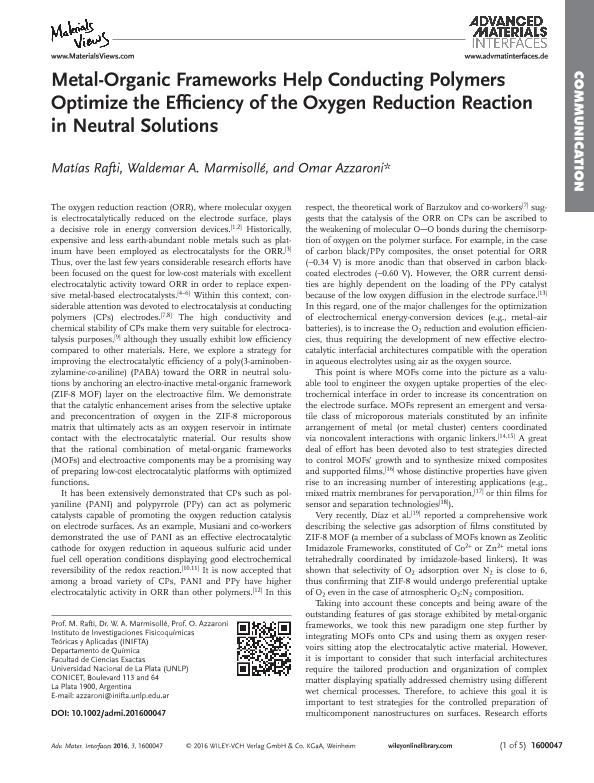Artículo
Metal-organic frameworks help conducting polymers optimize the efficiency of the oxygen reduction reaction in neutral solutions
Fecha de publicación:
19/08/2016
Editorial:
John Wiley & Sons Ltd
Revista:
Advanced Materials Interfaces
ISSN:
2196-7350
Idioma:
Inglés
Tipo de recurso:
Artículo publicado
Clasificación temática:
Resumen
The oxygen reduction reaction (ORR), where molecular oxygen is electrocatalytically reduced on the electrode surface, plays a decisive role in energy conversion devices. Historically, expensive and less earth-abundant noble metals such as platinum have been employed as electrocatalysts for the ORR. Thus, over the last years considerable research efforts have been focused on the quest for low cost materials with excellent electrocatalytic activity towards ORR in order to replace expensive metal-based electrocatalysts. Within this context, considerable attention was devoted to electrocatalysis at conducting polymers (CPs) electrodes. The high conductivity and chemical stability of CPs make them very suitable for electrocatalysis purposes,although they usually exhibit low efficiency compared to other materials. Here, we explore a strategy for improving the electrocatalytic efficiency of a poly(3-aminobenzylamine-co-aniline) (PABA) towards the ORR in neutral solutions by anchoring an electro-inactive metal-organic framework (ZIF-8 MOF) layer on the electroactive film. We demonstrate that the catalytic enhancement arises from the selective uptake and preconcentration of oxygen in the ZIF-8 microporous matrix that ultimately acts as an oxygen reservoir in intimate contact with the electrocatalytic material. Our results show that the rational combination of MOFs and electroactive components may be a promising way of preparing low-cost electrocatalytic platforms with optimized functions.
Palabras clave:
METAL ORGANIC FRAMEWORKS
,
CONDUCTING POLYMERS
,
OXYGEN REDUCTION
Archivos asociados
Licencia
Identificadores
Colecciones
Articulos(INIFTA)
Articulos de INST.DE INV.FISICOQUIMICAS TEORICAS Y APLIC.
Articulos de INST.DE INV.FISICOQUIMICAS TEORICAS Y APLIC.
Citación
Rafti, Matias; Marmisollé, Waldemar Alejandro; Azzaroni, Omar; Metal-organic frameworks help conducting polymers optimize the efficiency of the oxygen reduction reaction in neutral solutions; John Wiley & Sons Ltd; Advanced Materials Interfaces; 3; 16; 19-8-2016; 1-5
Compartir
Altmétricas




